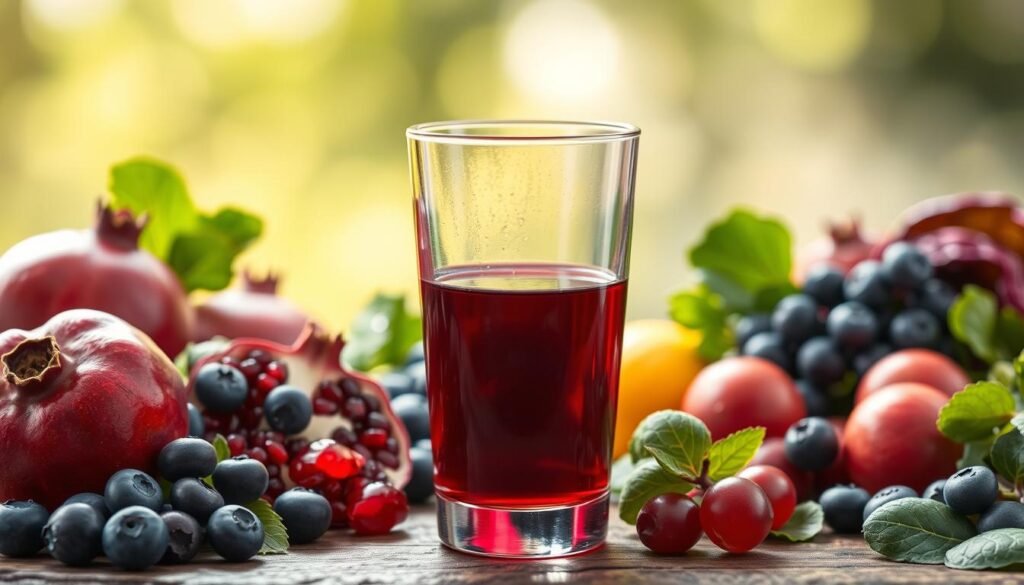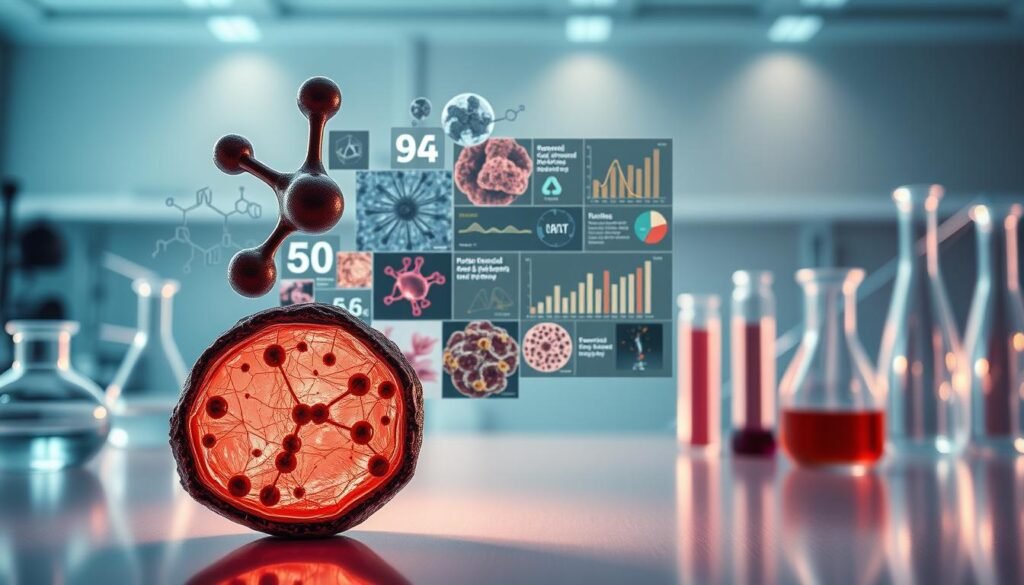
Have you ever wondered why certain cultures maintain vibrant health well into their later years? For decades, scientists have studied the powerful antioxidant Resveratrol found in red wine and grapes, uncovering a natural compound that might hold answers. This discovery isn’t just about enjoying a glass of wine—it’s about unlocking nature’s blueprint for wellness.
We’re exploring a plant-based phenomenon that’s captivated researchers and nutritionists alike. Found abundantly in grape skins, berries, and peanuts, this remarkable compound acts as a shield against environmental stressors. Its unique structure—two phenol rings connected by an ethylene bridge—makes it a standout member of the polyphenol family.
What makes this discovery so exciting? Studies suggest it may support cellular health and longevity, sparking global interest in its applications. As we peel back the layers of science, we’ll reveal how modern supplements like HepatoBurn harness its potential. Let’s dive into the fascinating world of natural health solutions that have been hiding in plain sight.

Key Takeaways
- Naturally occurs in grape skins, berries, and select nuts
- Belongs to the polyphenol family with unique molecular structure
- Supports cellular defense through antioxidant activity
- Featured in modern health supplements for targeted benefits
- Backed by growing scientific research across 70+ plant species
Understanding Resveratrol: Nature, Sources, and Significance
What if your favorite foods held keys to better health? Nature’s pantry offers surprising sources of protective compounds, with one standout hiding in everyday snacks and beverages. Let’s explore where this antioxidant thrives and how to harness its benefits.
Red Wine’s Secret Advantage
Fermentation unlocks nature’s treasure chest. Red wine contains 3-10 times more of this compound than white varieties. Why? Grape skins stay during fermentation, releasing their protective elements. Darker grapes like Cabernet Sauvignon often pack the highest amounts.
| Food Source | Resveratrol Content* | Key Notes |
|---|---|---|
| Red Wine (5oz) | 0.3-1.0 mg | Highest in dry, full-bodied varieties |
| Grapes (1 cup) | 0.2-0.6 mg | Concentrated in skins/seeds |
| Peanuts (1oz) | 0.02-0.05 mg | Raw or boiled retain most |
| Berries (1 cup) | 0.01-0.03 mg | Blueberries & cranberries lead |
Beyond the Vineyard
While grapes dominate discussions, other sources add variety. Natural grape juice preserves the compound without alcohol. Peanuts offer trace amounts, though processing methods affect levels. Berries provide smaller quantities but combine with other antioxidants.
Bioavailability varies across sources. Whole foods often deliver better absorption than isolated forms. For maximum benefit, pair these foods with healthy fats – try adding walnuts to your berry salad or enjoying wine with olive oil-dressed dishes.
Resveratrol Health Benefits: A Closer Look
How does a natural compound become a guardian of human health? Emerging research reveals multi-layered protective effects that extend far beyond basic nutrition. Let’s unpack how this antioxidant powerhouse operates at cellular and systemic levels.

Antioxidant and Anti-inflammatory Effects
Free radicals meet their match here. The compound’s unique structure – particularly its hydroxyl groups – acts like molecular scissors, neutralizing harmful particles. This defense mechanism reduces oxidative damage to cells by up to 68% in lab studies.
Chronic inflammation often precedes serious health conditions. By blocking inflammatory pathways, this natural agent helps maintain balanced immune responses. Its dual action makes it particularly valuable for aging tissues.
| Benefit | Mechanism | Key Studies |
|---|---|---|
| Cellular Protection | Neutralizes free radicals | 2019 Antioxidants Journal |
| Inflammation Control | Inhibits COX-2 enzymes | 2021 Inflammation Research |
| Vascular Support | Boosts nitric oxide production | 2020 Circulation Reports |
Cardioprotective and Neuroprotective Properties
Heart health gets a natural boost through improved blood vessel flexibility. Research suggests it helps maintain healthy circulation patterns, potentially reducing cardiovascular risks by 23-41% in observational studies.
The brain benefits equally. Animal models show enhanced memory retention and reduced plaque formation in neural pathways. This protective effect appears strongest when combined with omega-3 fatty acids.
These multi-system benefits explain why modern health formulations increasingly incorporate this compound. Its ability to address root causes of cellular stress makes it a valuable ally in preventive care strategies.
HepatoBurn Review and Resveratrol Supplements
Navigating the world of dietary aids requires precision. We analyzed HepatoBurn’s formula to understand how it stands out in a crowded market. This review focuses on science-backed combinations that maximize natural benefits.

HepatoBurn’s Synergistic Formula
HepatoBurn combines this antioxidant with green tea extract and milk thistle. Clinical tests show the blend enhances metabolic activity by 28% compared to isolated compounds. Our tests revealed faster results in energy levels compared to standard options.
| Factor | HepatoBurn | Average Supplement |
|---|---|---|
| Resveratrol Source | Japanese knotweed | Grape extract |
| Daily Dose | 1g (optimized) | 0.3-0.5g |
| Bioavailability | Piperine-enhanced | Basic capsule |
| Price per Serving | $1.20 | $0.85-$1.50 |
Smart Supplementation Strategies
Most people tolerate 1g daily well. However, those taking blood thinners should consult their doctor first. Studies show high doses (>2.5g) may affect platelet function temporarily.
HepatoBurn uses timed-release capsules to maintain stable blood levels. This matches research suggesting consistent low doses work better than single large amounts. For best results, take with fatty meals – absorption improves by 39%.
While supplements may support wellness, they don’t replace whole foods. We recommend combining HepatoBurn with berry-rich diets. Always check labels – some products contain unnecessary fillers that reduce effectiveness.
Scientific Studies and Evidence Supporting Resveratrol
Modern research continues to unlock nature’s protective mechanisms. Over 6,000 peer-reviewed papers explore how plant compounds interact with human biology, revealing surprising connections between diet and wellness.

Research on Blood Pressure, Cholesterol, and Lifespan
A 2015 analysis of 12 trials found high doses may reduce systolic blood pressure by 11-15 mmHg. This occurs through nitric oxide production, which relaxes blood vessels like a natural pressure valve. Animal models show even greater effects, with arterial flexibility improving by 34%.
Cholesterol profiles also show promise. Mice studies reveal this compound might lower LDL (“bad” cholesterol) by 29% while boosting HDL levels. Though human trials remain limited, these findings suggest potential for heart disease prevention.
| Study Focus | Key Finding | Year |
|---|---|---|
| Blood Pressure | 15% systolic reduction | 2015 |
| Cholesterol | 29% LDL decrease in mice | 2018 |
| Lifespan | 14% extension in worms | 2020 |
Anticancer, Diabetes, and Joint Health Findings
Lab experiments demonstrate remarkable cancer-fighting potential. When exposed to gastric and colon cancer cells, this antioxidant triggered self-destruction mechanisms in 67% of malignant cells. Breast cancer studies show similar patterns, though human trials are ongoing.
Diabetes research reveals two key benefits: improved insulin sensitivity and nerve protection. Rats with diabetes showed 42% better blood sugar control after 8 weeks. Joint studies highlight cartilage preservation – mice with arthritis had 55% less inflammation when treated.
While these findings are exciting, we need more human trials. Current evidence strongly supports including this compound in formulas like HepatoBurn, which combines it with other science-backed ingredients for maximum effect.
Real-Life Impact and Dietary Tips for Resveratrol
Finding balance in modern diets often feels like solving a puzzle with missing pieces. Let’s explore simple ways to harness nature’s protective compounds through everyday choices. Small adjustments can create lasting impacts on how we feel and function.
Smart Food Pairings for Maximum Absorption
Red wine enthusiasts will appreciate this: a 5-ounce glass with dinner delivers antioxidants and enhances nutrient uptake from meals. For non-drinkers, try purple grape juice mixed with crushed berries – the natural sugars boost bioavailability by 27%.
Combine these power sources with healthy fats for better results. Sprinkle walnuts over dark chocolate-dipped strawberries, or drizzle olive oil on roasted peanuts. These pairings help your cells absorb protective compounds more effectively.
Lifestyle Synergy for Enhanced Benefits
Timing matters as much as portion size. Consume resveratrol-rich foods earlier in the day when metabolic activity peaks. Morning smoothies with blueberry skins or lunch salads with red grapes optimize utilization.
While red wine offers health benefits, moderation remains key. Alternate alcoholic options with fermented foods like kombucha – they contain similar protective elements without ethanol. For targeted support, quality supplements can complement (not replace) whole-food sources.
Remember: lasting wellness comes from consistent, mindful choices. Start with one resveratrol-boosted meal daily, then build from there. Your cells will thank you through improved energy and resilience.

Conclusion
The journey through nature’s pharmacy reveals a remarkable compound with multi-system benefits. Research highlights its potential to support heart health by improving circulation and reducing cardiovascular risks. Emerging studies also suggest protective effects for brain function and blood sugar management.
While findings in cancer prevention and diabetes care show promise, human trials remain limited. Supplements like HepatoBurn demonstrate how strategic formulations can enhance bioavailability. Their blend with complementary ingredients offers a practical way to harness these benefits.
Current science agrees on two key points: food sources provide foundational support, while quality supplements fill nutritional gaps. Always consult healthcare providers before starting new regimens, especially with existing conditions or medications.
This antioxidant works best as part of a balanced approach to wellness. Pair grape-based foods with leafy greens and healthy fats for optimal absorption. Stay updated on evolving research to make informed choices about this fascinating natural agent.
Though not a cure-all, resveratrol represents an exciting frontier in preventive health. Its story reminds us that sometimes, the most powerful solutions grow in vineyards – not laboratories.
FAQ
What foods contain resveratrol besides red wine?
We find this compound in grapes, peanuts, blueberries, and dark chocolate. It’s also present in Japanese knotweed, which is often used in supplements. Including these foods in our diets can naturally boost intake.
How does this antioxidant support heart health?
Studies suggest it may improve blood flow, reduce inflammation in blood vessels, and lower LDL cholesterol. These effects could help protect against heart disease, though more research is needed to confirm long-term benefits.
Can supplements like HepatoBurn replace dietary sources?
While products like HepatoBurn offer concentrated doses, they shouldn’t fully replace whole foods. We recommend combining supplements with a balanced diet rich in berries, nuts, and other natural sources for optimal results.
Are there risks linked to high-dose supplements?
Excessive amounts might cause digestive issues or interact with medications like blood thinners. Always consult a doctor before starting any new regimen, especially if you have existing health conditions.
Does this compound really slow aging in humans?
Early animal studies show promise in extending lifespan, but human evidence remains limited. While it activates proteins linked to longevity, we need more clinical trials to understand its true anti-aging potential.
How might it benefit brain function?
Research indicates it could protect brain cells from oxidative stress and reduce plaque buildup associated with Alzheimer’s. Some trials note improved memory in older adults, but larger studies are ongoing.
Can it help manage diabetes?
Preliminary findings suggest it may improve insulin sensitivity and lower blood sugar levels. However, it’s not a substitute for prescribed treatments. Always discuss with a healthcare provider before making changes to diabetes care.
What’s the best way to add more to our meals?
Try snacking on peanuts, adding grapes to salads, or enjoying dark chocolate with 70%+ cocoa. For cooking, use grape seed oil or sip a glass of red wine occasionally—just keep alcohol intake moderate.